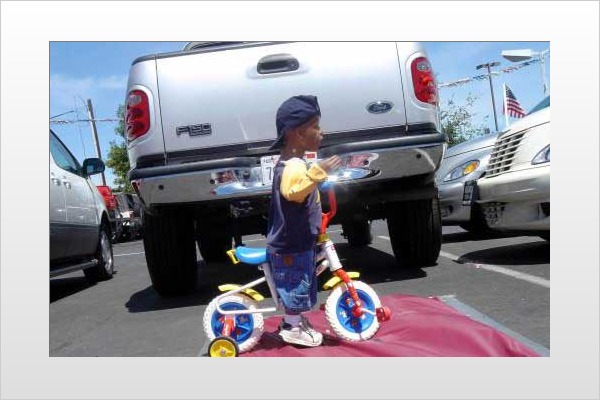
On December 30, 2005, Angela Gridley was doing laundry while on vacation in South Carolina. Her youngest daughter, Aliviah, age 2, climbed up into her lap, gave her a kiss and a hug, told her she loved her and climbed down. Then she went back outside to her father, Tim Gridley, who was having trouble untangling their dogs' leashes. In an effort to untangle them, he temporarily set the dogs free. When they bolted, Gridley's brother jumped in his pickup truck to chase them down. "As quick as a little one could run," her mother recalls, "Aliviah darted behind the truck before anyone could realize it." Tim's brother, Aliviah's uncle, backed out of the driveway, striking Aliviah and killing her.
In 2007 alone, the deaths of 232 children resulted from nontraffic incidents, the majority being accidental backovers. And each year since 2002, more than 9,000 nontraffic injuries have occurred, according to the nonprofit organization KidsAndCars.org. The federal government doesn't track these incidents, because they don't happen on public roads and usually don't involve a crash. How long will it be until the government finally sets a rear visibility standard, potentially saving hundreds, perhaps thousands, of children's lives? If Janette Fennell, founder and president of Kids and Cars, has her way, not much longer.
KidsAndCars.org, a national nonprofit safety organization, has taken the point position in advocating that the U.S. Department of Transportation (which oversees the National Highway Traffic Safety Administration) create a viable rearward visibility standard to ensure safety behind all vehicles. Believe it or not, currently there is not a rear visibility standard on the books — and there never has been. In the meantime, according to Fennell, more than 100 children die from backovers annually and thousands more are injured.
"You can't avoid hitting something you simply cannot see. Most people don't realize how prevalent this problem is," Fennell said, "or how preventable it is."
Due at least in part to the pressure applied by KidsAndCars.org and other safety advocacy groups, in July 2005 President Bush signed a $286.4 billion transportation bill: the Safe, Accountable, Flexible, Efficient Transportation Equity Act: A Legacy for Users (SAFETEA-LU). One provision of the act requires the Department of Transportation and related agencies to study effective methods for reducing injuries and deaths involving passenger vehicles that are backing up.
The act's passage opened the door for the Cameron Gulbransen Kids Transportation Safety Act of 2007 (HR 1216), which requires that all U.S.-marketed vehicles be designed to prevent backing incidents by providing an unobstructed rear view. Note that the Act does not specify that automakers add cameras, sensors or LCD displays to their vehicles to meet the rear visibility standard. Automakers can meet the standard when it is finalized any way they see fit. About 41 percent of 2009 models had standard or optional rearview cameras.
In past decades, both foreign and domestic automakers resisted safety innovations that are now standard equipment, such as seatbelts and airbags. After years of opposing the Cameron Gulbransen Kids Transportation Safety Act, the Alliance of Automobile Manufacturers, representing nine automakers, supported the final version that was passed into law.
Cameron Gulbransen was 2 years old when he ran behind his father's SUV on October 19, 2002. "Suddenly, I noticed a small bump in the vehicle," his father, Dr. Greg Gulbransen, remembers. "Quickly, I jumped from the vehicle and saw the most devastating scene of my life: My little Cameron was lying down with his blanket in his hand while bleeding profusely from his head. As a physician, I knew it was the end."
KidsAndCars.org is not alone in advocating for a rear visibility standard. Other supporting groups include Public Citizen, Consumers Union, the American Academy of Pediatrics and Advocates for Highway and Auto Safety.
Not waiting for the final regulation, a number of automakers have begun offering cameras and sensors as standard or optional equipment. But all vehicles can be retrofitted to help improve rearward visibility. A number of innovative aftermarket suppliers have begun offering products to prevent backover deaths. Many are available right now, including cutting-edge offerings from Audiovox, Gentex, Kenwood and Magna Donnelly. (See photos at left.)
"Our products are ready today," says Tom Malone, senior vice president of sales for Audiovox. "Drivers don't have to wait for mandatory legislation that might take years to implement."
On June 20, 2003, at approximately 11:42 a.m., Kaycie Lynn Blood was riding her purple 20-inch bicycle in the Tu-Su Circle cul-de-sac near her home in Apple Valley, California. At the same time, a San Bernardino County trash truck was collecting trash on Tonkin Avenue. Kaycie followed the truck from some distance, waving to the driver as he performed his duties. He waved back. At the south end of the cul-de-sac, the garbage truck reversed to execute a three-point turn and exit the cul-de-sac. The audible back-up warning device, as required under the California Vehicle Code, did not operate. Kaycie Lynn Blood was struck by the truck and died at the scene.
"Everyone would agree that the worst thing that can ever happen is to lose a child," Janette Fennell stated. "Add to that that you were somehow responsible — that you were the driver of the vehicle. Most parents never get over it."
"Kaycie left us far too early," says Amy Blood, Kaycie's mother. Blood's family met with members of Congress and asked them to implement a rear visibility standard for all U.S.-sold vehicles. "It's important to our family to make sure that her death does not simply become another faceless statistic. We don't want to see another child backed over and killed."
To learn more about vehicle visibility issues, read "Visibility: Now You See Me...Now You Don't."
Thanks to KidsAndCars.org for helping us collect information for this article.